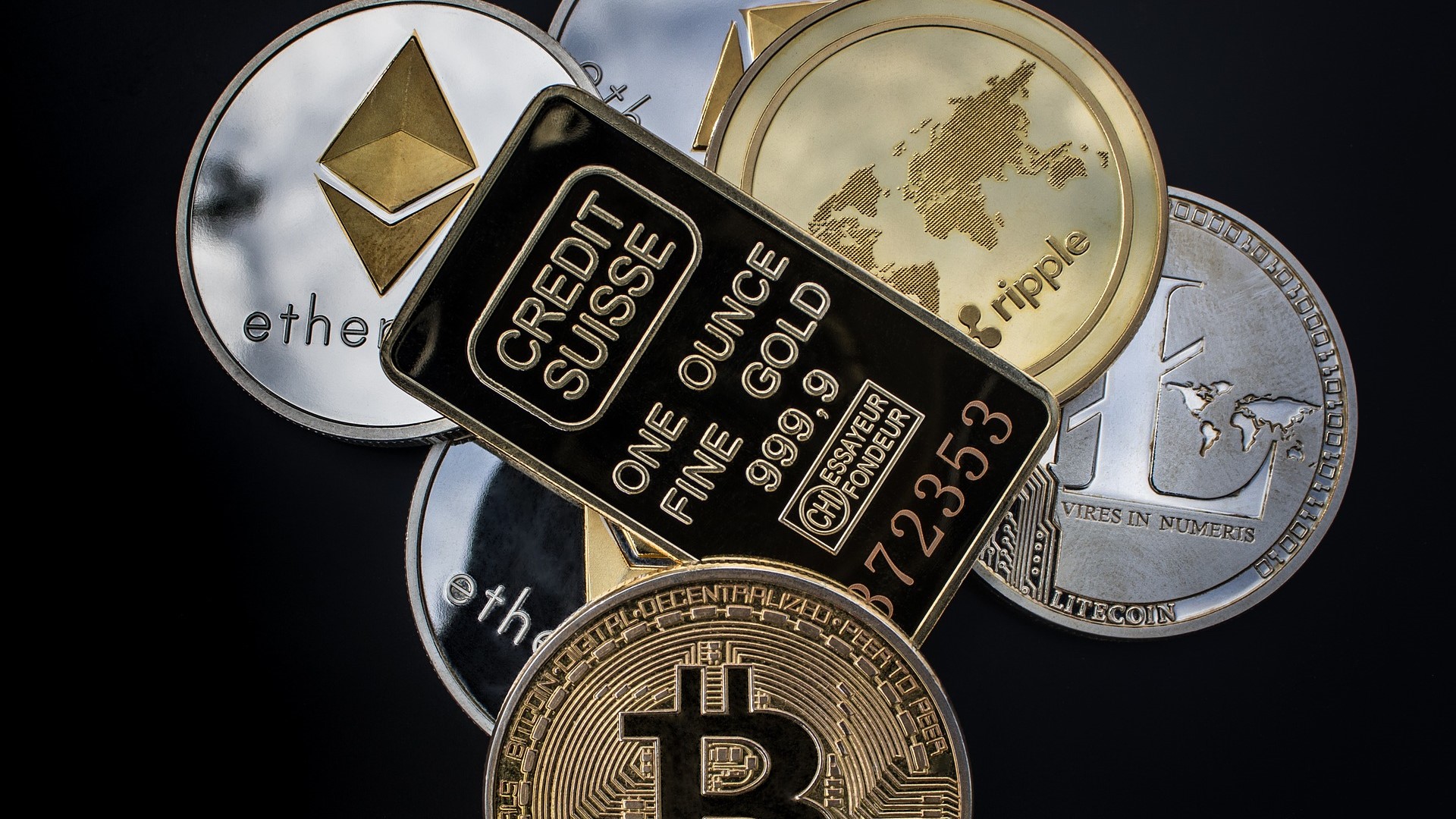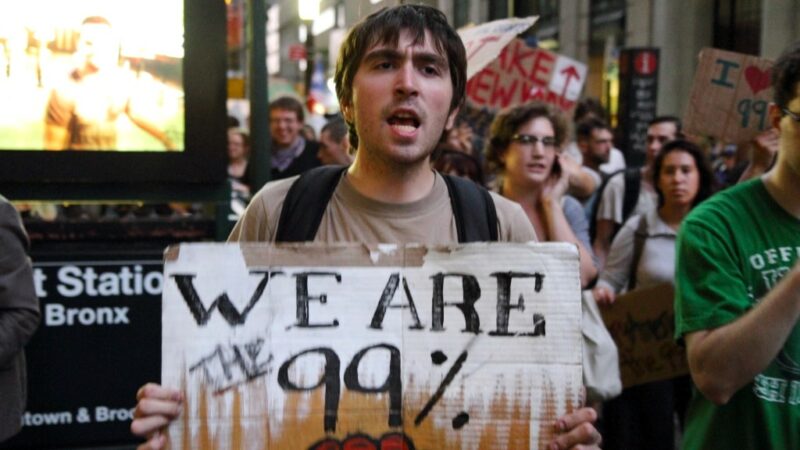 The state’s monopoly on money is ultimately uncontrolled, which has advantages and disadvantages. But when the state announces its needs and politics interferes, monetary policy can become a threat to freedom and prosperity. Monetary competition could counteract this, and cryptocurrencies could be an effective means of doing so. (Image by WorldSpectrum on Pixabay)
The state’s monopoly on money is ultimately uncontrolled, which has advantages and disadvantages. But when the state announces its needs and politics interferes, monetary policy can become a threat to freedom and prosperity. Monetary competition could counteract this, and cryptocurrencies could be an effective means of doing so. (Image by WorldSpectrum on Pixabay) When the cryptocurrency Bitcoin rose from around $1,000 in early January of 2017 to over $19,200 by December of 2017, interest in cryptocurrencies skyrocketed in both economic circles and in the general public. However, this interest seemed to be motivated less by the possibilities for monetary reform of private currencies[1]and a potentially emerging currency competition between private and government money (as discussed in monetary policy circles since the 2008 financial crisis),[2] and more by the very human and legitimate inclination for profit. The dominant question was whether a lucrative profit opportunity had until now been criminally neglected. Interest in private currencies and cryptocurrencies therefore decreased in 2018 as Bitcoin prices fell.
Should We Defend the State Monopoly on Money at All Costs, or Put Freedom First?
Unsurprisingly, increasing attention has again been paid to cryptocurrencies, starting in 2020 when Bitcoin prices rose once again. However, since these price increases can clearly be traced back to the Coronavirus crisis and its debt-financed government attempts to cope with it, the dominant issue discussed in the public today is a regulatory one. Rarely has a federal finance minister called so clearly for the prevention of the establishment of private money. The state must, he said, defend its monopoly on money. And this week the Financial Times even questioned whether Bitcoin and digital money could end the dominance of the U.S. dollar.[3]
In view of the new global sovereign debt peaks generated by the Coronavirus crisis, which seems to have prompted even the Financial Times to abandon familiar thought patterns, we must recall that the relevant regulatory policy question is not the one formulated by Olaf Scholz, Germany’s Federal Minister of Finance. For the relevant regulatory question is not how the state can defend its monopoly on money by any conceivable means; rather, according to Walter Eucken’s Grundsätzen der Wirtschaftspolitik [“Principles of Economic Policy”] it is, “what forms of order grant freedom”?[4]
A primacy of law and freedom can only become a practical reality if effective limits are set on government action—including on monetary policy. Only the sovereign of a liberal democratic polity, the citizen, can set these limits.
What forms of monetary order grant freedom? What this means here is not more freedom of action for governments, but the freedom of the individual citizen. It is not about the primacy of politics, but about the primacy of law and freedom.
However, a primacy of law and freedom can only become a practical reality if effective limits are set on government action—including on monetary policy. Only the sovereign of a liberal democratic polity, the citizen, can set these limits. This is not about anarchy or anarcho-capitalism, but about power and counter-power in the sense understood by the Catholic classical liberal Lord Acton. It is about an order of freedom. Genuine decentralized bourgeois counter-power, which helps to preserve law, freedom, and the market economy across national borders, and which largely prevents monetary and interest rate manipulation, can only be created by allowing competing private currencies. No one voluntarily holds bad money. And the decentralized mass demand for good money is a decentralized bourgeois countervailing power that no government and no European Central Bank can stop once the state monopoly on money has been abolished or softened. The softening of the state monopoly on money started with the development of cryptocurrencies shortly after the financial crisis of 2007-2008 and has been evolving ever since.[5]
Currency Competition: Cryptocurrencies as a Countervailing Power to the State Monopoly
Cryptocurrencies are a use case of competing private currencies in the sense understood by Friedrich Hayek. Since cryptocurrencies, despite the state monopoly on money, are not so easy to ban (or a ban is not easily enforceable due to their decentralized digital construction), they play a particularly relevant role in the process of the emergence of decentralized countervailing power to the state monopoly on money.
To understand the phenomenon of cryptocurrencies and to be able to distinguish them from other digital currencies (such as digital central bank money or stable coins like Libra, which is now called Diem), it is important to realize that cryptocurrencies are the media of peer-to-peer networks that allow people to conduct acts of exchange while cutting out intermediaries such as central banks and commercial banks. The ideal goal of these peer-to-peer networks is decentralized and direct cooperation between people without intermediaries being able to manipulate the terms of that cooperation. Ideally, these peer-to-peer networks should be able to handle large volumes of transactions quickly, cheaply, transparently, securely, and anonymously.
In very simplified terms, a cryptocurrency—or more precisely, a peer-to-peer cryptocurrency network—is composed of four elements:
- Distributed Ledger Technology or Decentralized Ledger Protocol
- Consensus-building mechanism
- Authentication and anonymization of users by means of cryptographic procedures, and a
- Payment system with its own currency.
A Distributed Ledger or Decentralized Ledger Protocol is that in which the transactions of the peer-to-peer network are entered. It is a file that is stored on many computers of the participants in the peer-to-peer network, so that if a computer is accessed destructively or if it is shut down by the state or otherwise, the account book is preserved. As the distribution of this file becomes broader and more global, it becomes more difficult to cripple the associated peer-to-peer network or enforce a ban on the entire network. A distributed ledger can be organized as a blockchain[6], but it can also be organized through alternative methods.[7]
Questions of Authorization, Consensus, Authentication, and Verification
Now, of course, the following questions arise from the area of clearing and settlement: Who is allowed to enter what into the decentrally distributed ledger? And how is it ensured that an entry in the decentrally distributed ledger really reflects a transaction by users? How is consensus established on this before all decentrally distributed files can subsequently be synchronized? How do users authenticate themselves on the peer-to-peer network? Who verifies this and how? And who actually pays those who maintain the decentrally distributed ledger and perform the necessary consensus checks and authentications? Only death is free, and not even that.
From these questions, it is immediately apparent that, in addition to a distributed ledger, a consensus-building mechanism is needed to check and verify individual transactions before they can be entered into the decentrally distributed ledger of the peer-to-peer network. If this checking and verification were to be carried out by only one central body, there would emerge a significant opening, first, for fraud opportunities and, second, for the enforcement of a ban on a cryptocurrency peer-to-peer network. The more computers that are involved in this task, distributed as globally as possible, the more difficult it will be to manipulate consensus building or to override this necessary element for maintaining the peer-to-peer network.
Of course, this also applies to the authentication and anonymization of the participants in this network. No matter how elaborately cryptography (symmetric or asymmetric, etc.) is used to anonymize and authenticate the individual users, if this task is performed by a central body, this central body can be manipulated or paralyzed much more easily than it can in a process performed by many globally distributed computers.
Peer-to-Peer Networks: Decentralized Cooperation without Higher-Level Intermediaries
Since the goal of peer-to-peer networks is to enable decentralized and direct cooperation among people without intermediaries such as central banks and commercial banks being able to manipulate the terms of that cooperation, a peer-to-peer network requires a payment system with its own currency as a necessary element to pay those who manage the distributed ledger, perform the necessary checks and consensus building, and perform authentication and anonymization. Regarding this necessary element of peer-to-peer networks, if it is managed by a central authority then there will emerge an opening to manipulate or shut down the entire system. The more decentralized and global the organization of this mining and payment process is, the more difficult this becomes.
The concrete design and combination of the four necessary elements of a peer-to-peer network then results in the full-potential of a cryptocurrency regarding transaction volume, transaction speed, transaction costs, transaction security, and transaction transparency.
Unfortunately, as the development of today’s best-known cryptocurrency shows, Bitcoin has significant shortcomings when measured against the ideal goals of a peer-to-peer network. Both the organization of Bitcoin’s distributed ledger and Bitcoin’s very elaborate, increasingly complex, and ever-more-consuming verification and consensus-building process, which consumes more and more computing capacity and energy costs, have resulted in, among other things, Bitcoin’s transaction speed and volume being low and its transaction costs being very high. The high concentration of the mining process in localized oligopolies, which has its origin in the design of the first two elements of this peer-to-peer network, also offers many opportunities for government agencies to enforce a ban on Bitcoin. If, without notice, power is cut off to Bitcoin miners in China, it is at least questionable whether miners outside of China will be able to quickly make up for this loss of capacity to keep the entire network running.
Bitcoin Is Not the Last Word
However, these and other problems do not refute the whole concept of cryptocurrencies. Initial attempts at new technologies will never be perfect. It is crucial that competition produces better products. There are now over 3,900 cryptocurrencies listed (as of December 2020),[8] but these need to be examined in light of the four elements explained above to determine whether they are truly cryptocurrency peer-to-peer networks or merely digital coins. And if they are cryptocurrency peer-to-peer networks, then it is necessary to examine what specifically is going on in these networks and whether anything is going on there at all. Are they peer-to-peer instruments used for transactions at all or are they purely objects of speculation?
More than ten years of extensive experience with the cryptocurrency Bitcoin shows that the one ideal cryptocurrency, which would displace all other currencies, cannot ultimately exist. If the management of a cryptocurrency is strictly decentralized, transaction speed decreases and transaction costs increase. If the verification and consensus generation algorithm become increasingly complex and elaborate for security reasons, there may be concentrations of “verifiers.” If, on the other hand, management is centralized, the central office can manipulate the system and is vulnerable to government intervention.
The one perfect cryptocurrency cannot be designed in one fell swoop. It is therefore crucial that “currency competition as an evolutionary process”[9] can drive the development of ever better cryptocurrencies. The main benefit of the new technology for a free society and the development of a market-based monetary order is not the constructivist conception of the one new ideal currency that is supposedly capable of solving our economic problems. The main benefit of this new technology for a free society is that currency competition among cryptocurrencies can produce a variety of ever improving and diverse cryptocurrencies for different purposes and needs, and that this competition among cryptocurrencies, beyond the realm of this new technology, should also exert salutary competitive pressure on both other private currencies and government currencies.
Currency Competition Leads to Better Money
Since no one voluntarily holds bad money, evolving currency competition will encourage all private, as well as all government, money producers to produce better money. The production of bad money—whether cryptocurrency, other private money, or government money—would be punished by people through their migration to competing money if they had free choice between distinguishable private and government currencies.
The real trial-and-error processes are probably still ahead of us. And it is obvious that the entire technology that made cryptocurrencies possible in the first place will shake up the business models of the previous intermediary institutions in the financial industry. But central banks are also watching the entire development very closely and are looking into digital central bank money.[10]
In terms of regulatory policy, this creates an overall situation in which the state monopoly on money is visibly facing competition, which will gain enormous relevance in terms of economic and monetary policy if cryptocurrencies, for whatever reason—but presumably in the course of the next financial crisis, which is likely to be a monetary crisis—could be increasingly used by the broad masses as competing private currencies.
It is questionable, however, whether it will be, as the Financial Times provocatively asked this week, the best-known of all cryptocurrencies, Bitcoin, that will break the dominance of the U.S. dollar. Bitcoin has significant design flaws for the reasons explained above. Conceivably, and probably more likely, in a situation where citizens lose confidence in state money, a set of different cryptocurrencies will effectively compete with state currencies.
This is a slightly revised version of a text originally published in German by Flossbach von Storch Research Institute on December 11, 2020: https://www.flossbachvonstorch-researchinstitute.com/de/kommentare/erneutes-interesse-an-kryptowaehrungen/.
English translation by Thomas and Kira Howes.
Notes:
[1] See Friedrich Hayek: The Denationalization of Money—The Argument Refined: An Analysis of the Theory and Practice of Concurrent Currencies, 3rd ed. (London: The Institute of Economic Affairs, 1990 [1976]).
[2] See Thorsten Polleit, Michael von Prollius, Frank Schäffler and Norbert F. Tofall: “Überwindung der Krise durch gutes Geld,” in: Frankfurter Allgemeine Zeitung (June 5, 2009) Nr. 128, p. 12; see also Frank Schäffler and Norbert F. Tofall: “Währungswettbewerb als Evolutionsverfahren. Der Übergang vom staatlichen Papiergeldmonopol zu einer marktwirtschaftlichen Geldordnung ist evolutionär mittels Wettbewerb möglich,” in Peter Altmiks (ed.): Im Schatten der Finanzkrise. Muss das staatliche Zentralbankwesen abgeschafft werden? (Munich: Olzog, 2010), p. 135-55, and Frank Schäffler and Norbert F. Tofall: “Euro-Stabilität durch konkurrierende Privatwährungen,” in: Dirk Meyer (ed.): Die Zukunft der Währungsunion. Chancen und Risiken des Euros, with contributions from Helmut Schmidt, Václav Klaus, Arnulf Baring, Roland Vaubel, Wolf Schäfer, Hans-Olaf Henkel, Charles B. Blankart and others (Berlin: LIT, 2012), 275-88.
[3] See, https://on.ft.com/33WAjZ1
[4] Walter Eucken: Grundsätze der Wirtschaftspolitik, edited by Edith Eucken and K. Paul Hensel, 5th ed.., unmodified edition (Tübingen: Mohr Siebeck, 1975), 179.
[5] See, regarding this and the following paragraphs, Norbert F. Tofall, “Währungsverfassungsfragen sind Freiheitsfragen. Mit Kryptowährungen zu einer marktwirtschaftlichen Geldordnung?” Studie zu Wirtschaft und Politik des Flossbach von Storch Research Institute (January 15, 2018), pp. 7-10; available online at: https://www.flossbachvonstorch-researchinstitute.com/de/studien/waehrungsverfassungsfragen-sind-freiheitsfragen/.
[6] See Melanie Swan: Blockchain. Blueprint for a New Economy (Cambridge et al: O’Reilly, 2015).
[7] See Tony Arcieri: On the Dangers of a Blockchain Monoculture, blogpost (January 5, 2016), available online at: https://tonyarcieri.com/on-the-dangers-of-a-blockchain-monoculture.
[8] See www.coinmarketcap.com.
[9] See Frank Schäffler and Norbert F. Tofall: “Währungswettbewerb als Evolutionsverfahren…”
[10] See Norbert F. Tofall: “Der digitale Renminbi als geopolitisches Mittel” Kommentar zu Wirtschaft und Politik des Flossbach von Storch Research Institute (November 17, 2020); see also Norbert F. Tofall: “Digitales Zentralbankgeld,” Kommentar zu Wirtschaft und Politik des Flossbach von Storch Research Institute (February 14, 2020).



